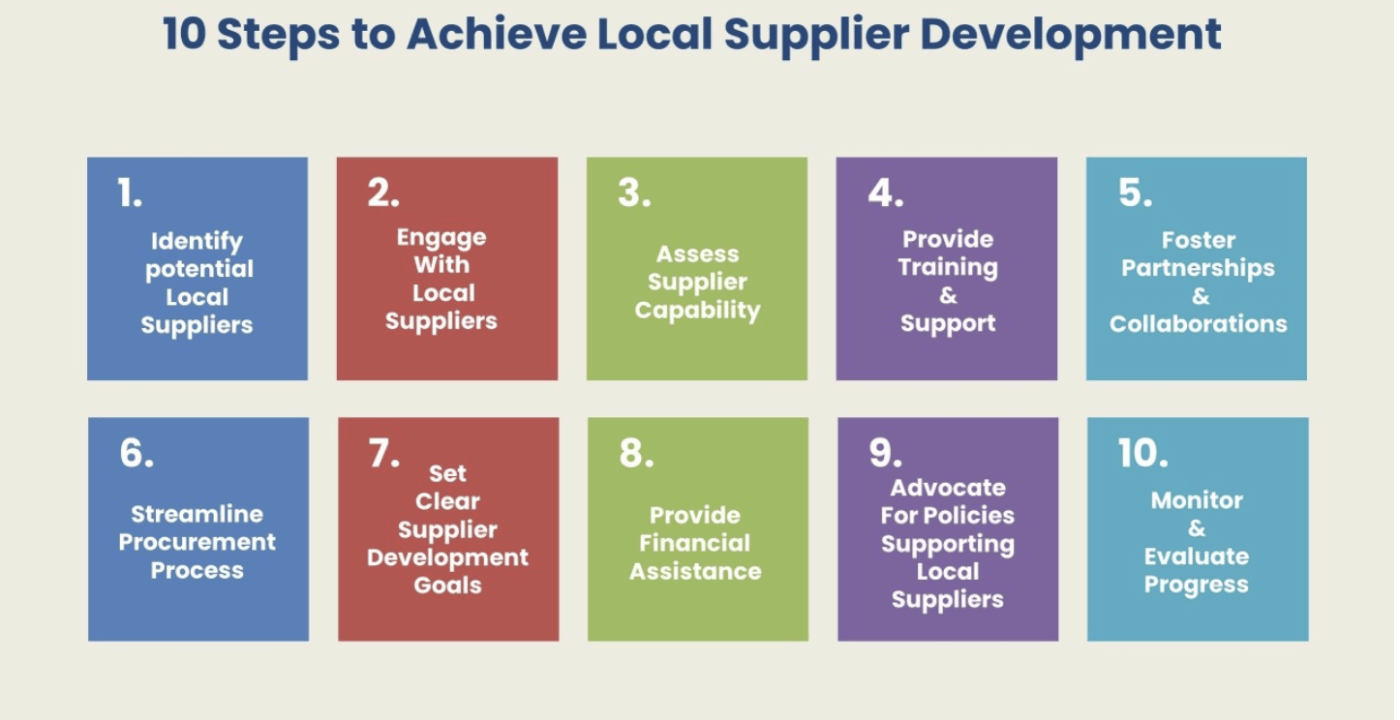Achieving local supplier development requires a strategic and collaborative approach. Text is based on knowledge provided by Idar Nouti. Follow Idar Nouti on LinkedIn.
Content
Achieving local supplier development requires a strategic and collaborative approach
Here are some steps you can take to promote and facilitate the growth of local suppliers:
- Identify potential local suppliers: Conduct market research to identify local businesses that have the potential to become suppliers. Look for companies that align with your industry, have the necessary capabilities, and meet your quality and compliance standards.
- Engage with local suppliers: Reach out to local suppliers and establish relationships with them. Attend local business events, trade fairs, and networking opportunities to connect with potential suppliers. Encourage open communication and collaboration to understand their needs and capabilities.
- Assess supplier capabilities: Evaluate the capabilities and capacities of potential local suppliers. Assess their production capacity, quality control measures, financial stability, and ability to meet your requirements. Identify any gaps or areas where they may need support or improvement.
- Provide training and support: Offer training programs and support to local suppliers to enhance their skills, knowledge, and capabilities. This could include providing technical training, mentoring, or access to business development resources. Help them understand your specific requirements, standards, and processes.
- Foster partnerships and collaborations: Encourage partnerships and collaborations between local suppliers and larger companies or organizations within your industry. This could involve facilitating connections, joint ventures, or subcontracting opportunities. Encourage supplier development programs that foster knowledge sharing and skill transfer.
- Streamline procurement processes: Simplify and streamline your procurement processes to make it easier for local suppliers to participate. Reduce administrative burdens, provide clear guidelines, and offer assistance with documentation and compliance requirements. Transparent and efficient procurement processes can incentivize local suppliers to engage with your organization.
- Set clear supplier development goals: Establish clear goals and metrics for local supplier development within your organization. These goals could include specific targets for the percentage of procurement spent with local suppliers or the number of local suppliers engaged. Regularly track and monitor progress toward these goals.
- Provide financial assistance: Explore options for providing financial support to local suppliers. This could include offering loans, grants, or access to working capital through partnerships with financial institutions or government programs. Financial assistance can help local suppliers invest in equipment, technology, or other resources needed for growth.
- Advocate for policies supporting local suppliers: Engage with policymakers and industry associations to advocate for policies that promote local supplier development. This could involve lobbying for preferential treatment for local suppliers in public procurement, tax incentives, or regulations that support local business growth.
- Monitor and evaluate progress: Continuously monitor and evaluate the progress of your local supplier development initiatives. Assess the impact on local suppliers, track their growth, and gather feedback to identify areas for improvement. Use this information to refine your strategies and optimize the effectiveness of your supplier development efforts.
Local Supplier development is a long term process
Remember that local supplier development is a long-term process that requires commitment, collaboration, and ongoing support. By nurturing and investing in local suppliers, you can contribute to the growth of local economies and create sustainable business relationships.
Learn more about Supplier development with the help of EFFSO.
Learn more about Supplier Development in EFFSO’s course. A part of a tactical buyer role is executing a supplier development program. But how do you align the program with your company’s strategy? How do you focus the program on your key development areas? How do you even get started? Answer to these questions are key to your success and are answered in this introduction course. Learning Objectives of the course are:
- Aligning with Company Strategy: Learn to synchronize your supplier development program with your company’s overall strategy.
- Focusing on Key Development Areas: Discover how to identify and prioritize key areas for supplier development.
- Getting Started: Gain practical insights into initiating a successful supplier development program.
About Learn How to Source
Learn How to Source is an online platform based in Sweden, offering a range of procurement courses accessible globally. It serves as a community where procurement experts share their knowledge through online courses, designed for various experience levels from introductory to expert. Courses are concise, about 30 minutes each, and cover different aspects of procurement, tailored for different buyer roles. The courses focus on practical knowledge, presented by seasoned professionals, and include quizzes and certificates. They can be accessed from any device, emphasizing micro learning for flexibility and efficiency.
Note: Illustration to blogpost “Achieving local supplier development” is the provided by Idar Nouti.
